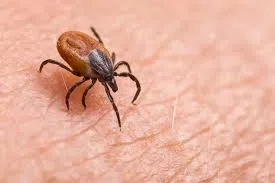As warmer weather approaches, the Illinois Department of Public Health (IDPH) has issued a warning about tick season and Lyme Disease Awareness Month in May. They are urging residents to take precautions against ticks and Lyme disease.
“Lyme disease is a serious bacterial infection transmitted through the bite of infected ticks,” said IDPH Director Dr. Sameer Vohra. “Lyme Disease is the most common vector-borne illness in the United States affecting more than 500,000 people nationally each year.”
Dr. Vohra emphasized the importance of checking for ticks. “As the summer approaches, I encourage our residents to learn to ‘Fight the Bite’ and protect yourself and your loved ones from tickborne illnesses. If you have been in wooded or high grassy areas and are experiencing symptoms – fever, fatigue, headache and a circular rash – see your health care provider immediately,” said Vohra.
The IDPH has developed educational materials such as Pocket Cards and a Tick Defense Knowledge Check crossword puzzle for school-aged children to help families learn about tick protection.
Dr. Vohra highlighted the need to regularly check oneself, pets, and children for ticks after spending time in tick-prone areas. Removing ticks within 24 hours can reduce the risk of disease transmission.
Besides Lyme disease, tickborne diseases like Rocky Mountain Spotted Fever, Tularemia, Ehrlichiosis, and Babesiosis can be life-threatening. Rocky Mountain Spotted Fever can cause death within five days of symptom onset.
Residents are advised to contact healthcare providers immediately if they develop a fever or rash after being in tick-prone areas.
The IDPH has also created an interactive Tick Surveillance Map, detailing tick species and the diseases they may carry across Illinois counties.
Public health officials warned travelers to be cautious about the higher prevalence of Lyme disease in areas like Wisconsin, Minnesota, parts of Michigan, and the northeastern United States.
IDPH also added more information about how to avoid tickborne illnesses. This includes the following…
- Learn about tick removal and symptom awareness HERE.
- Walk in the center of trails. Avoid wooded, bushy areas with high grass and leaf litter. Our Camper Checklist provides more details on how to protect yourself.
- Wear light-colored clothing to make ticks easier to find. Tuck long pants into socks and boots.
- Apply an EPA-registered insect repellent containing 20% DEET, picaridin, IR3535, or Oil of Lemon Eucalyptus according to label directions. The EPA has a search tool that can help you find the product that best suits your needs.
- Conduct full-body tick checks on family members (underarms, ears, belly button, behind knees, between legs, waist, hair and scalp) every two to three hours. Also check any gear or pets taken on outings.
- To kill ticks after being outdoors, put clothes in the dryer on high for 10 minutes (or one hour for damp clothes).
- Bathe or shower within two hours after coming indoors.
- If you find a blacklegged tick on you that may have been attached for more than three days, then seek medical attention to decide if you need an antibiotic to prevent Lyme disease.
- It is often helpful to keep the tick for species identification. Place the tick in rubbing alcohol or in a sealed bag/container to bring to your healthcare provider or local health department for submission to IDPH. A submission form can be found HERE on the IDPH website.

Comments